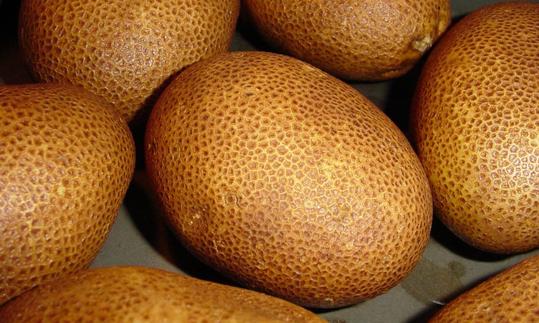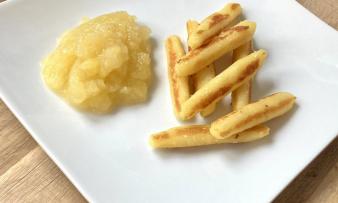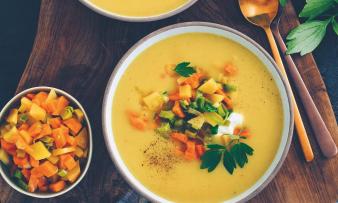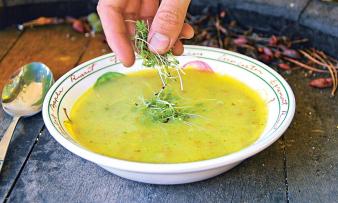Table of contents
The cultivated Russet potato variety is a floury potato, usually not organic. Due to their above-average length and high starch content, they are particularly suitable for making French fries in the fast food sector.
Use in the kitchen
What are Russet potatoes? The most commonly used potato variety in North America is Russet Burbank. It is a floury potato and is particularly suitable for making baked potatoes, casseroles, mashed potatoes, potato soups, stews and for making chips, croquettes and French fries. Floury potatoes are also used to make potato dough for dumplings and gnocchi. The flesh of this variety is rather white. Like other floury potatoes, they have a coarse, dry consistency, coupled with a strong flavor and a tendency to pop frequently when cooked.
Their skin is dark brown (russet = rust-red), sometimes with a marbled pattern. Cooking often makes the skin even darker. The shape is mostly long, oval, unusual and often larger than other varieties. Potatoes can be divided into different cooking types based on their cooking behavior. A different cooking type should be chosen depending on the intended use. The starch content depends on the variety, weather and ripeness and often varies. The values are different depending on the source - so they are given here as approximate values:
- Waxy potatoes have a rather moist flesh and are usually long to oval in shape. They are harvested earlier than floury potatoes. The starch content is rather low at around 11-13%, which means that the skin remains intact during the cooking process and does not burst. Waxy potatoes include Allians, Belana, Goldmarie or Princess. These varieties are ideal for preparing potato salad, gratin, fried potatoes or jacket potatoes. 1
- Most waxy potatoes, on the other hand, have a starch content of around (13-15%) and are therefore average. They are suitable for many recipes. Well-known varieties include Gala, Marabel, Milva or Toscana. These tubers can be used to make mashed potatoes, fried potatoes, jacket potatoes or baked potatoes. 1
- Floury potatoes almost fall apart after cooking and have the highest starch content: between 14 and 16%. Popular varieties include Adretta, Gunda, Lilly and Ivory Russet. 2 They can be used to make dishes such as mashed potatoes, dumplings and gnocchi. They are also suitable for soups and stews. 1
What would be a Russet potato alternative? Since the Russet variety is primarily produced for industrial French fries production, 2 all floury potatoes can be used for most recipes.
Vegan recipe for baked potatoes with herb quark filling
Ingredients (for 2 people): 2 large boiled potatoes (starchy with skin, organic), 50 g frozen peas, 200 g vegan quark, 70 g soy yoghurt, 1 bunch of fresh chives, ½ bunch of fresh parsley, 2 tsp onion powder, 1 tsp garlic powder, ½ tsp sea salt.
Preparation: Preheat the oven to 200 °C top and bottom heat. Place the cooked potatoes on a tray and bake in the oven for about 10-15 minutes until they are warm. Uncooked potatoes need about 40-60 minutes in the oven. Rinse the fresh herbs, dry them and chop them finely. Mix the chopped herbs with the other ingredients for the vegan herb curd. Boil the peas in water for about 2 minutes and then rinse them with cold water. Take the potatoes out of the oven, cut them open and spread the herb curd in the middle. Put the peas on the plates and serve the baked potatoes with the vegan herb curd filling warm.
Vegan recipe for gnocchi
Ingredients: 1 kg floury potatoes (organic), 500 g wheat flour, 100 g durum wheat semolina.
Preparation: Boil the potatoes for about 30 minutes and then rinse with cold water. Peel and use a hand blender to make a puree. Add flour and semolina to the mashed potatoes and use your hands to form a homogeneous dough for about 5-10 minutes. Form part of the dough into rolls about 2 cm thick and cut into 1.5 cm pieces. Put only a portion of the cut gnocchi into a large pot of boiling salted water. After about 5-10 minutes (depending on size), the gnocchi will float to the surface. At this point, remove the gnocchi with a slotted spoon. Until serving, drizzle vegan gnocchi with a little rapeseed oil so that they do not stick together.
Vegan recipes with russet potatoes can be found under the note: " Recipes that have the most of this ingredient ".
| Not only vegans or vegetarians should read this: Vegans often eat unhealthily. Avoidable nutritional errors. |
Purchasing - Storage
Where can you buy Russet potatoes? Russet potatoes cannot be found in supermarkets such as Coop, Migros, Denner, Volg, Spar, Aldi, Lidl, Rewe, Edeka, Hofer, Billa etc. or in organic supermarkets such as Denn's Biomarkt and Alnatura. These refined potatoes are produced exclusively for industrial customers and only for conventional cultivation. Other varieties are in circulation for organic cultivation. For home cultivation, seed tubers can occasionally be obtained from seed companies.
Alternatively, you can use any floury potato variety for your own use. These are available in all standard supermarkets regardless of the season. Weekly markets also offer potatoes with a higher starch content. Many shops also have organically produced potatoes on offer. Organically grown, frequently used potatoes in the firm to floury category are: Agria, Victoria (suitable for French fries), Desirée (red skin), Jelly or Laura (intense red skin, yellow flesh). Floury to very floury potatoes used in industrial production include Hermes (chip production), Markies (industrial), or Lady Rosetta (chips, red skin). 3
The availability of floury potatoes varies depending on the size of the store, catchment area, etc. Our recorded food prices for the DA-CH countries can be found above under the ingredient image - and by clicking you can see their development at various suppliers.
Storage tips
The Russet Burbank potato variety has a long shelf life. At around 7 °C, it can be stored for up to 5 months. When do raw potatoes get black spots? If stored for a long time, black spots (IBS = internal black spots) can appear in the flesh, especially if the harvest was too early. 4 The temperatures vary slightly depending on the variety, but temperatures that are too low (< 5 °C) increase the sugar content of the potatoes and impair the baking quality. 5
Potatoes should always be stored separately from other types of fruit and vegetables. If you buy potatoes in a plastic bag, you should take them out after purchase and put them in a cardboard box or store them in an air-permeable material such as linen or jute. If the potatoes are damp, they should definitely be dried before storage to prevent rotting. However, storing them in a place that is too dry can also cause potatoes to wilt. Good air circulation is therefore recommended during storage. Storing them in dark rooms or in a covered box is very important, as light encourages the potatoes to germinate and turn green, which leads to the formation of solanine. Unwashed, earthy potatoes last the longest. Washing can damage the skin and cause unwanted bruises.
Ingredients - Nutritional values - Calories
100 g of raw Russet Burbank potatoes provide 79 kcal of energy. The carbohydrate content is 18 g, proteins 2.1 g and the fat content is very low at 0.08 g. 6 These values, as well as the starch content, fluctuate greatly. They differ from year to year depending on the type of cooking and the year of cultivation.
Potatoes are not particularly rich in vitamins, but vitamin B6 (pyridoxine) is significant at 0.34 mg/100g. This content covers 25% of the daily requirement. Yams (0.29 mg/100g) and wild rice (0.39 mg/100g) have similar values. Dried wild garlic contains a particularly high amount of this vitamin at 2.8 mg/100g, although smaller amounts tend to be used. 6
Among the macro-minerals, potassium has a good share at 417 mg/100g (21% of the daily requirement). The contents of wild rice (427 mg/100g) and Jerusalem artichoke (429 mg/100g) are similarly high. Dried herbs such as coriander (4466 mg/100g) and dill (3308 mg/100g) contain particularly high amounts, although we usually only consume small amounts of these. 6
The manganese content is relatively low and amounts to 0.16 mg/100g. This covers 8% of the daily requirement. The same amount is contained in the Hokkaido pumpkin, for example. Wholegrain rice, on the other hand, contains higher amounts of the trace element (4 mg/100g). 6
Potatoes are rich in secondary plant compounds such as phenols, flavonoids, polyamines and carotenoids. Different factors such as genotype, agronomic factors, post-harvest storage, cooking methods and processing conditions influence the concentration and stability of these compounds. 7
The complete ingredients of Russet potatoes, the coverage of the daily requirement and comparison values with other ingredients can be found in our nutrient tables. In the article Nutrients explained you will get a detailed insight into the topic.
Effects on health
The nutritional value of potatoes, in general, lies primarily in the starch and biologically high-quality protein they contain. The method of preparation has a significant influence on the nutrient content and the effects on health. You can find detailed information on this in the article: Potato, raw (organic?).
Secondary plant substances
The content of phenols, carotenoids and anthocyanins is relatively low compared to other types of fruit and vegetables. Studies also disagree on how preparation methods affect the content of secondary plant substances. Both increases and decreases were observed compared to the raw form. 8
Dangers - Intolerances - Side effects
The health benefits of just boiled or steamed potatoes (without fat and salt) are significantly better than eating fried potatoes or potato products. This is because, especially when potatoes are heated several times, many other harmful substances are created in addition to the carcinogen acrylamide, such as heterocyclic amines, polycyclic aromatic hydrocarbons, aldehydes and acrolein, a very toxic aldehyde. These substances increase the risk of developing cancer. The study links the regular consumption of certain fried foods (including French fries) with an increased risk of developing prostate cancer. The study does not answer whether this risk applies specifically to fried foods or whether it is related to the regular consumption of highly heated foods and/or other aspects of the western lifestyle (fast food consumption). 9
High heating of hydrogenated fats and oils produces so-called trans fats. Trans fats have a negative effect on cholesterol in the blood. This increases inflammation in the body and increases the risk of developing coronary heart disease. 10 Even compared to saturated fat, trans fats are less effective. In addition, trans fats can also harm an unborn child in the mother's womb. 11 The EU set an upper limit of 2% for trans fats from 2021. There are exceptions for foods that naturally contain trans fats. 12 Denmark, Austria, Hungary, Norway and Switzerland have also implemented such upper limits. In New York, a general ban on trans fats came into force in 2008. 13
In conventional farming, potatoes are generally one of the crops that require the most pesticide applications. Bioland estimated that pesticides are used 5 to 7 times per planting season. 14 Since industrial potatoes have to be flawless for sale, this can also be assumed for the Russet variety. Chlorpropham (CIPC), a herbicide and growth regulator, is a popular agent in conventional potato farming because it prevents the potato from germinating (germination inhibitor). The metabolites produced during metabolism are considered to be highly toxic and carcinogenic in humans and animals, among other things. CIPC is banned in Switzerland 16 and the EU 17.
Excessive exposure to light leads to a build-up of solanine in potatoes, which can be seen by green discoloration. 18 This can occur if potatoes grow too close to the surface or if they are stored in too much light. The solanine content can also increase if potatoes are bruised or if they are sprouting. 19 Solanine is considered toxic. The content cannot be reduced by heating, but only by removing the skin and boiling in water. 20 You can read more about this in the ingredient Potato, raw (organic?).
Ecological footprint - animal welfare
The CO 2 footprint is primarily used to assess the climate friendliness of a food. This depends on various factors. The type of agricultural production (conventional vs. organic), seasonal, regional or domestic production or import by truck, ship or plane, different types of packaging and whether the goods are fresh or frozen all play a decisive role. 21
1 kg of fresh potatoes (organic and conventional) has a CO 2 footprint of between 0.2 and 0.39 kg CO 2 eq/kg, although this value can vary slightly from manufacturer to manufacturer. 21,22 The amount of water required to produce 1 kg of potatoes is 287 litres. 23 We were unable to find any specific information about the Russet variety.
For detailed explanations of various sustainability indicators (such as ecological footprint, CO2 footprint, water footprint), see our article: What does the ecological footprint mean?.
Worldwide occurrence - cultivation
The origin of potatoes ( Solanum tuberosum) lies in South America, but today's varieties are no longer adapted to the tropics. Today, cultivation is common outside of tropical, arctic and subarctic climate zones, i.e. increasingly in cool temperate climate zones. 24
The Russet Burbank variety probably dates back to LL May & Co.'s breeding as Netted Gem in 1902. The names Netted Gem and Russet Burbank were used synonymously for many years. The maternal lineage included potato varieties such as Rough Purple Chili, Garnet Chili, Early Rose and Burbank. 25
Found in the wild
The Russet potato variety cannot be found in any form in the wild.
Cultivation - Harvest
Potatoes are very adaptable and grow almost anywhere, provided there is no waterlogging or the soil is too hard. You can find more information on cultivation in the article Potatoes, raw (organic?).
Further information
Potatoes ( Solanum tuberosum) are a nightshade plant (Solanaceae). They reproduce vegetatively via the starchy tubers. Of the many plants whose underground storage organs mainly contain starch as a reserve material, only four species or genera are established as food: cassava, sweet potato, yam and potatoes. Although not closely related to Solanum tuberosum, Jerusalem artichoke ( Helianthus tuberosus) is often referred to as a potato or earth artichoke.
The popularity of the Russet Burbank variety increased in the 1940s and 1950s with the help of certain fast food chains and the invention of frozen French fries. In 1930, this variety accounted for only 4% of the volume produced in the United States. By 2012, it had grown to almost 70% in the United States and Canada. That is over 40% of the total potato acreage in the United States. 25
Since 2018, the Ivory Russet variety has also been listed on the Swiss potato variety list. 2 The ripening times of the Russet varieties vary greatly, from medium early to late. The Ivory Russet in particular is a medium early variety with long oval tubers, some of which are misshapen. The starch content is between 15 and 17%. The sensitivity to impact damage is not so bad, and the storage capacity is very good. This variety is susceptible to potato Y virus, among other things, and not very susceptible to late blight, tuber rot, scab and iron spot. 26
The well-known Russet Burbank variety has a long growth phase, is very sensitive to stress and therefore requires regular watering. Russet Burbank produces few flowers and is a very disease-prone variety, such as bacterial soft rot, dry rot, leaky rot, pink rot, silver scurf, black scurf, seed piece rot, wilt, late blight, leaf roll necrosis and bacterial ring rot. Russet Burbank is also sensitive to net necrosis, the black spots on the skin. Therefore, spraying with systemic and partially systemic agents is very often necessary in conventional farming. 27
The White Russet variety is the first genetically modified potato (Innate) that was approved in the USA in November 2014. Simplot used the Russet Burbank variety as the starting variety. It develops brown spots less quickly during storage and even when peeled it stays light for longer. When heated, it is said to produce less harmful acrylamide. Even though large fast-food chains are still resisting putting this genetically modified variety into circulation, there are numerous shops and restaurants in the USA that process and sell this variety fresh or frozen. Since 2015/2016, varieties with resistance to late blight and tuber blight have been developed using genetic engineering. Here, too, the Russet Burbank variety is the starting variety. 28
Alternative names
The Russet variety is sometimes called the Idaho potato. In English, it is referred to as "russet potatoes" or "idaho potatoes", sometimes incorrectly spelled "russett potatoes", "russets potatoes" or "russet potato".
Bibliography - 27 Sources (Link to the evidence)
| 1. | Die Kartoffel de: Von mehlig bis fest: die unterschiedlichen Kochtypen. 2016. |
| 2. | Schwärzel R, Torche JM et al. Schweizer Sortenliste für Kartoffeln 2021. Agroscope Transfer. 2020;362:1–6. |
| 3. | Bioaktuell ch: Sortenliste 2024. Ausgabe Schweiz. Nr. 1041. |
| 4. | University of Nebraska-Lincoln. Institute of Agriculture and Natural Resources. CropWatch. Russet Burbank: Management Profile. |
| 5. | Nachhaltig leben ch: Kartoffeln lagern - So bleiben sie am längsten frisch. |
| 6. | USDA United States Department of Agriculture. |
| 7. | Ezekiel R, Singh N et al. Beneficial phytochemicals in potato—A review. Food Research International. 2013;50(2):487–496. |
| 8. | Tian J, Chen J. Health benefits of the potato affected by domestic cooking: A review. Food Chemistry. 2016;202:165–175. |
| 9. | Stott‐Miller M, Neuhouser ML, Stanford JL. Consumption of deep‐fried foods and risk of prostate cancer. The Prostate. 2013;73(9):960–969. |
| 10. | Eidgenössische Ernährungskommission. EEK Bericht. Fette in der Ernährung. 2012 (pdf). |
| 11. | Stender S, Dyerberg J. Influence of trans fatty acids on health. Ann Nutr Metab. 2004;48(2):61–66. |
| 12. | European Commission. Commission Regulation (EU) 2019/649. 2019. |
| 13. | Mouratidou T, Livaniou A et al. Trans fatty acids in Europe: where do we stand? JRC Science and Policy Reports. 2014. |
| 14. | Pini U. Das Bio-Food-Handbuch. Hamburg, Potsdam: Ullmann; 2014. |
| 16. | Bio Suisse. Merkblatt zur Vermeidung von Kontaminationen durch unerlaubte Keimhemmungsmittel auf Knospe-Kartoffeln und Knospe-Lagergemüse. 2021. |
| 17. | |
| 18. | Ahmed SS, Müller K. Einfluss von Lagerzeit, Licht und Temperatur auf den Solanin- und α-Chaconingehalt mit und ohne Keimhemmungsmittel behandelter Kartoffeln. Potato Research. 1981;24(1):93–99. |
| 19. | WHO World Health Organization. Toxicological evaluation of certain food additives and naturally occuring toxicants. Solanine and Chaconine. WHO Food Additive Series 30. |
| 20. | Focus de: Solanin - So meiden Sie den Giftstoff im Gemüse. 2020. |
| 21. | Reinhardt G, Gärtner S, Wagner T. Ökologische Fussabdrücke von Lebensmitteln und Gerichten in Deutschland. IFEU Institut für Energie- und Umweltforschung Heidelberg. 2020:1-22. |
| 22. | Concito. Denmark's green think tank. The big Climate Database. Version 1.1. Potato. 2024. |
| 23. | Mekonnen MM, Hoekstra AY. The green, blue and grey water footprint of crops and derived crop products. Hydrol. Earth Syst. Sci. 2011;15:1577-1600. |
| 24. | Brücher H. Tropische Nutzpflanzen. Ursprung, Evolution und Domestikation. Berlin: Springer Verlag; 1977. |
| 25. | Bethke PC, Nassar AMK et al. History and Origin of Russet Burbank (Netted Gem) a Sport of Burbank. Am J Potato Res. 2014;91(6):594–609. |
| 26. | Agroscope. Kartoffelsorte Ivory Russet. 2017. |
| 27. | University of Nebraska-Lincoln. Institute of Agriculture and Natural Resources. CropWatch. Russet Burbank: Characteristics. |
| 28. | Transgen de. White Russet: Direktvermarktung einer Gentechnik-Kartoffel. 2016. |











Comments